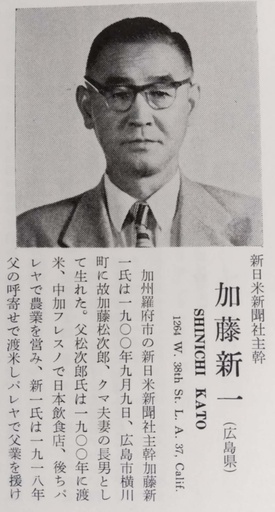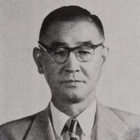From 1900 to 1961
In "A Hundred Years of Immigration to America," published in Japan in 1962 based on "A Hundred Years of Japanese Americans in the United States: Records of Development" published in 1961, author Kato Shinichi wrote in the preface that he had just entered junior high school in 1916 when he was called by his father and came to the American mainland.
At the time of the outbreak of the war (Japan-US), he was working as editor in chief of the American Industrial Daily Newspaper in Los Angeles, and was soon interned, but returned to Japan on the first exchange ship in the summer of 1942. This was also his own wish. He wrote that in Japan, "I experienced life as a newspaperman in the mainland during the most difficult period of the war and the postwar period, and returned to the United States in 1953, where I remain to this day."
In summary, Kato was born in Japan, but was called to America by his father, who had already gone there, when he was in junior high school, and lived there, and at the time of the outbreak of war between Japan and the United States, he was the editor-in-chief of a Japanese-language newspaper called Beikoku Sangyo Nippo. However, he was detained by the US government as someone involved in the Japanese media, and then returned to Japan on a Japan-US exchange ship, and worked in the newspaper industry in Japan throughout the war and after the war. In 1953, he returned to America again.
Born in Hiroshima City

It says that he had just become a junior high school student in 1916, so we know his approximate age, but we don't know his birthplace or details. I thought that he was a very modest author, and looked again at the 1,400-page "Centennial History" to see if there was anything I could learn from him. There was, in the chapter on "Southern California," which includes Los Angeles, a half-page introduction to Shinichi Kato was included, complete with a photo of his face.
Kato, who is both the editor and the author, naturally compiled this himself. Normally, it would have been published as an introduction to the editor (author), but Kato probably chose to include himself in the "Records of People."
Although it is a bit long, I would like to introduce the entire article below. His title is listed as "Chief Editor of the New Japan and America Newspaper Company," the same as in the colophon of this book, and his address at the time is also listed.
Shinichi Kato (Hiroshima Prefecture)
1264 W, 38th St. LA 37, Calif.
Shinichi Kato, editor of the New Japan-America Newspaper Company in Rafu City, California, was born on September 9, 1900, in Yokogawa-cho, Hiroshima City, as the eldest son of the late Matsujiro Kato and his wife Kuma. His father, Matsujiro, came to the United States in 1900 and ran a Japanese restaurant in Fresno, California, and later farmed in Pareja. Shinichi came to the United States in 1918 when his father called him to come, and helped out with his father's business in Pareja while studying at night school.
When his father returned to Japan, he moved to Pasadena, Southern California, and worked in the gardening business. From 1926 he worked as a reporter for the Rafu Nichibei and California Mainichi Shimbun newspapers, and from 1933 he served as executive director of the Southern California Central Agricultural Association and manager of the Southern California Agricultural Association Federation. During this time he founded the morning Rafu Agricultural Product Market Report broadcast, and from 1937 he became editor-in-chief of the American Industrial Daily News, and in 1940 he edited the "Comprehensive Directory of Japanese Industries in the United States."
When war broke out between Japan and the United States, he was imprisoned at the Mizola Internment Camp in Montana, and returned to Japan on the first exchange ship from New York in June of the same year. He worked for seven years as the head of the political department and deputy chief of the editorial department at the Chugoku Shimbun newspaper in his hometown of Hiroshima. In 1949, he was appointed head of the public relations department of Hiroshima Prefecture, and also served as secretary-general of the Hiroshima Prefectural Headquarters of the United Nations Association of Japan. He also served as secretary-general of the First World Federalist Asian Conference in Hiroshima in October 1952.
In 1953 he returned to the US as a correspondent for the Sankei Shimbun, later joining the Shin Nichibei Shimbunsha, where he brought his family over one after another, and in 1958 obtained permanent residency in the US, where he is currently the company's chief editor. He edited the company's 1955 and 1959 editions of the Directory of Japanese Americans in America, and in 1960 edited the 70-Year History of Japanese in Southern California, and in the same year was awarded a commendation by the Japanese government at the Japan-US Centennial Celebration, and was also awarded the Green and White Ribbon Medal by the Agricultural Association of Greater Japan. From that year through 1961 he edited the "Centennial History of Japanese Americans in America" and the "Directory of Japanese American Development", both published by the Shin Nichibei Shimbunsha.
He married his wife Akiko (the eldest daughter of Mishima Daitaro, a graduate of Tokyo Furendo Girls' School) in Rafu in 1927, and their only child, Kenneth Nao (27 years old), graduated from Shudo Gakuen High School in Hiroshima, studied at Rafu City University and Rafu State University, and joined the Rafu branch of the Bank of Tokyo in California in 1959. He currently works in the Foreign Affairs Department of the Rafu branch of the Bank of Tokyo.
Involved in peace activities
From the above profile, we can see that Kato Shinichi was born in Hiroshima Prefecture (Hiroshima City), a city that produced many immigrants, and after moving to the United States, he studied at night school while working in agriculture and other fields, and eventually became active in the field of journalism, including at a local Japanese language newspaper. When the war began, he was detained and returned to Japan. In Japan, he also became a reporter for the Chugoku Shimbun, where he held an important position. However, he did not stop there, and was involved in peace-related work in Hiroshima Prefecture. Then, he returned to the United States and worked for a Japanese language newspaper in the United States again. We can see that he was truly involved in a wide range of activities, straddling both Japan and the United States.
This was his career up to the age of 61, and what happened after that was unknown at the time this profile was found. What kind of life did he lead? Not only did he travel all over the United States researching his "Centennial History," but the path that this man known as Kato Shinichi walked is intriguing.
It is believed that he was in his hometown of Hiroshima when the atomic bomb was dropped, and this is all the more likely given that he was also involved in peace activities.
Using this profile as a guide, we will trace "Kato Shinichi and those around him" in more detail, including his work as a newspaper journalist in Hiroshima and his peace-related work that is deeply connected to Hiroshima.
(Titles omitted)
© 2021 Ryusuke Kawai






